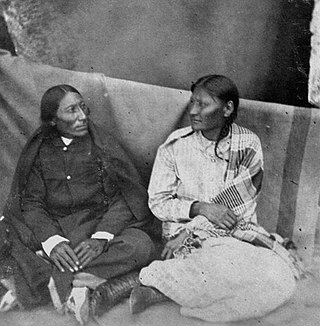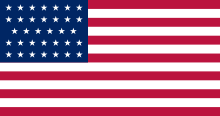
The Sand Creek massacre was a massacre of Cheyenne and Arapaho people by the U.S. Army in the American Indian Wars that occurred on November 29, 1864, when a 675-man force of the Third Colorado Cavalry under the command of U.S. Volunteers Colonel John Chivington attacked and destroyed a village of Cheyenne and Arapaho people in southeastern Colorado Territory, killing and mutilating an estimated 69 to over 600 Native American people. Chivington claimed 500 to 600 warriors were killed. However, most sources estimate around 150 people were killed, about two-thirds of whom were women and children. The location has been designated the Sand Creek Massacre National Historic Site and is administered by the National Park Service. The massacre is considered part of a series of events known as the Colorado Wars.

John Milton Chivington was an American Methodist pastor and Mason who served as a colonel in the United States Volunteers during the New Mexico Campaign of the American Civil War. He led a rear action against a Confederate supply train in the Battle of Glorieta Pass, and was then appointed a colonel of cavalry during the Colorado War.

Black Kettle was a prominent leader of the Southern Cheyenne during the American Indian Wars. Born to the Northern Só'taeo'o / Só'taétaneo'o band of the Northern Cheyenne in the Black Hills of present-day South Dakota, he later married into the Wotápio / Wutapai band of the Southern Cheyenne.

The Territory of Colorado was an organized incorporated territory of the United States that existed from February 28, 1861, until August 1, 1876, when it was admitted to the Union as the State of Colorado.

Silas Stillman Soule was an American abolitionist, Kansas Territory Jayhawker, whose family aligned themselves with John Brown and Walt Whitman. Later, during the American Civil War, he joined the Colorado volunteers, rising to the rank of captain in the Union Army. Soule was in command of Company D, 1st Colorado Cavalry, which was present at Sand Creek on November 29, 1864, when he refused an order to join the Sand Creek massacre. During the subsequent inquiry, Soule testified against the massacre's commanding officer, John Chivington. Soon afterwards Soule was murdered, possibly in retaliation; dying at 26, Soule is honored as having led a heroic life of "moral courage" at great personal risk to himself.

The Sioux Wars were a series of conflicts between the United States and various subgroups of the Sioux people which occurred in the later half of the 19th century. The earliest conflict came in 1854 when a fight broke out at Fort Laramie in Wyoming, when Sioux warriors killed 31 American soldiers in the Grattan Massacre, and the final came in 1890 during the Ghost Dance War.

John Evans was an American politician, physician, founder of various hospitals and medical associations, railroad promoter, governor of the territory of Colorado, and namesake of Evanston, Illinois; Evans, Colorado; and Mount Evans, Colorado.

The Colorado War was an Indian War fought in 1864 and 1865 between the Southern Cheyenne, Arapaho, and allied Brulé and Oglala Sioux peoples versus the U.S. army, Colorado militia, and white settlers in Colorado Territory and adjacent regions. The Kiowa and the Comanche played a minor role in actions that occurred in the southern part of the Territory along the Arkansas River. The Cheyenne, Arapaho, and Sioux played the major role in actions that occurred north of the Arkansas River and along the South Platte River, the Great Platte River Road, and the eastern portion of the Overland Trail. The United States government and Colorado Territory authorities participated through the 1st Colorado Cavalry Regiment, often called the Colorado volunteers. The war was centered on the Colorado Eastern Plains, extending eastward into Kansas and Nebraska.

The 1st Colorado Infantry Regiment was a volunteer infantry regiment of the United States Army formed in the Colorado Territory in 1861 and active in the American West in the late 19th century.

The 3rd Colorado Cavalry Regiment was a Union Army unit formed in the mid-1860s when increased traffic on the United States emigrant trails and settler encroachment resulted in numerous attacks against them by the Cheyenne and Arapaho. The Hungate massacre and the display in Denver of mutilated victims raised political pressure for the government to protect its people. Governor John Evans sought and gained authorization from the War Department in Washington to found the Third. More a militia than a military unit, the "Bloodless Third" was composed of "100-daysers," that is, volunteers who signed on for 100 days to fight against the Indians. The unit's only commander was Col. George L. Shoup, a politician from Colorado. The regiment was assigned to the District of Colorado commanded by Col. John M. Chivington.

Samuel Forster Tappan was an American journalist, military officer, abolitionist and a Native American rights activist. Appointed as a member of the Indian Peace Commission in 1867 to reach peace with the Plains Indians, he advocated self-determination for native tribes. He proposed the federal government replace military jurisdiction over tribal matters with a form of civil law on reservations, applied by the tribes themselves.

The Colorado Territory was formally created in 1861 shortly before the bombardment of Fort Sumter sparked the American Civil War. Although sentiments were somewhat divided in the early days of the war, Colorado was only marginally a pro-Union territory. Colorado was strategically important to both the Union and Confederacy because of the gold and silver mines there as both sides wanted to use the mineral wealth to help finance the war. The New Mexico Campaign was a military operation conducted by Confederate Brigadier General Henry Sibley to gain control of the Southwest, including the gold fields of Colorado, the mineral-rich territory of Nevada and the ports of California. The campaign was intended as a prelude to an invasion of the Colorado Territory and an attempt to cut the supply lines between California and the rest of the Union. However, the Confederates were defeated at the Battle of Glorieta Pass in New Mexico and were forced to retreat back to Texas, effectively ending the New Mexico Campaign.
The Treaty of Fort Wise of 1861 was a treaty entered into between the United States and six chiefs of the Southern Cheyenne and four of the Southern Arapaho Indian tribes. A significant proportion of Cheyennes opposed this treaty on the grounds that only a minority of Cheyenne chiefs had signed, and without the consent or approval of the rest of the tribe. Different responses to the treaty became a source of conflict between whites and Indians, leading to the Colorado War of 1864, including the Sand Creek Massacre.

Edward Wanshear Wynkoop was an American US Army Colonel during the American Civil War. He was a founder of the city of Denver, Colorado. Wynkoop Street in Denver is named after him.
James Hobart Ford was a Union colonel and brevet brigadier general during the American Civil War, notable for his contributions in the Trans-Mississippi Theater of the war.
The Department of Kansas was a Union Army command department in the Trans-Mississippi Theater during the American Civil War. This department existed in three different forms during the war.

Mochi was a Southern Cheyenne woman of the Tse Tse Stus band and the wife of Chief Medicine Water. Mochi, then a 24-year-old, was a member of Black Kettle's camp and was present on the morning of November 29, 1864, when John Chivington and over 650 troops of the First Colorado Cavalry, Third Colorado Cavalry and a company of the 1st Regiment New Mexico Volunteer Cavalry attacked Black Kettle's winter camp at Sand Creek on the plains of eastern Colorado Territory.
The Hungate massacre involved the murder of the family of Nathan Hungate along Running Creek on June 11, 1864. It was a precipitating factor leading to the Sand Creek massacre of November 29, 1864.

Fort Weld, also called Camp Weld, began as a military camp on 30 acres east of the Platte River in what is now the La Alma-Lincoln Park neighborhood of Denver, Colorado. It was named for Lewis Ledyard Weld, the first Territorial Secretary. The central square of the post was used to practice drills of the troops. Buildings—soldier's quarters, officers' headquarters, mess rooms, a hospital, and a guard house—surrounded the square. The main entrance to the camp was on the eastern side of the post. It was established on September 1861 and abandoned in 1865.

Ochinee, also known as Lone Bear and One-Eye, was a Native American Peace Chief of the Cheyenne tribe. He was the father of Amache Prowers, a tradeswoman, advocate and leader among the Southern Cheyenne. Ochinee, who had worked to create peace for the Cheyenne, died during the Sand Creek massacre on November 29, 1864.
















